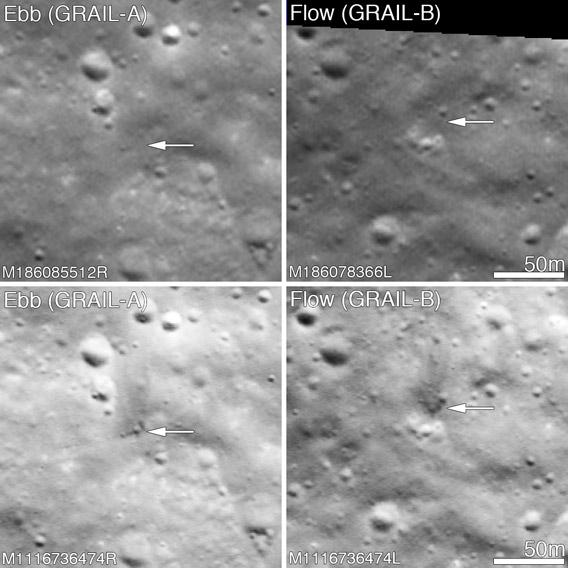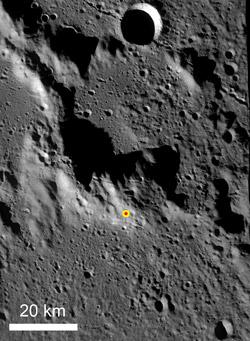The twin GRAIL probes were sent into orbit around the Moon in the last days of 2011, designed to use gravity itself to measure the Moon’s interior composition and structure. On Dec. 17, 2012 they were sent plummeting to the surface after completing their major objectives, slamming into the ground near the Moon’s north pole.
Another mission, the Lunar Reconnaissance Orbiter, was able to spot the impact sites where the two spacecraft met their doom, and you can see them in these before-and-after shots:

Image credit: NASA/GSFC/Arizona State University
On the left, stacked vertically, is where GRAIL A (nicknamed Ebb) hit, and on the right is GRAIL B (Flow). As you can see in the bottom images, there are dust plumes that fanned out over the surface that weren’t there before. Note the scale; each image is about 200 meters across, twice the length of a football field. That may sound big, but the Moon has a lot of crater-saturated real estate. It’s amazing they found these sites.

Image credit: NASA/GSFC/Arizona State University
They actually hit near the base of a massif, or long mountain, on the south-facing bank, just a couple of thousand meters apart—they were flying together in the same orbit, to help measure the change in gravity due to changes in density of the lunar material beneath them. The lower they flew, the better their measurements, so in the end their orbits were lowered to just a few kilometers above the Moon. The final impact was placed at the north pole to avoid any possible contamination of historical spots like the Apollo landings.
The two spacecraft each approached the surface at 1.6 kilometers per second (1 mile per second)—twice as fast as a rifle bullet—moving south to north. Note the excavated material fanned out to the north as you’d expect from a low-angle impact. The irregular distribution is unusual though. Each made craters about 5 meters (16 feet) across.
And there’s another surprise, too: the ejected material is dark. Usually, dust blown out by impacts is lighter in color than the surrounding material, eventually darkening over the eons as it gets zapped by cosmic radiation and whacked by micrometeorite impacts (like, for example, the rays around the relative young impact crater Tycho). It’s not clear why there’s darker material under the surface where the impacts were.
Even in death, GRAIL was trying to teach us something about the Moon.
Controlled impacts are common in planetary exploration when missions are at their ends. Engineers and scientists do try to squeeze out every last drop of information they can in situations like that, which I think is fine, and even noble. We should all do so well in our own last moments.